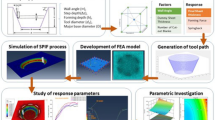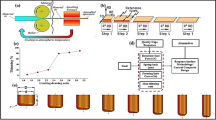Abstract
It is well recognized that formability depends on several material properties and process variables. The sheet metal surface roughness and material properties interact with lubricant type, quantity applied, and viscosity in a complex way to change friction. This work was undertaken to determine if the drawbead simulation tester could be used to obtain meaningful information related to the out-of-round (OOR) can production problem. Using the test, the performance of can stock that made OaR cans in production was compared to can stock that performed successfully. The results indicate some necessary can-body stock surface conditions for good production, but these are not necessarily limiting conditions.
Similar content being viewed by others
References
S.R. MacEwen et al.,, “The Science of Modelling Can Forming and Performance,” Aluminum Alloys for Packaging, ed. J.G. Morris et al. (Warrendale, PA: TMS, 1992), pp. 85–101.
T.C. Sun, “Surface and Metallurgy Effects in Wall Ironing of AA 3104,” Aluminum Alloys for Packaging, ed. J.G. Morris et al. (Warrendale, PA: TMS, 1992), pp. 183–192.
J.A. Schey, “Geometric Factors Affecting Results from the Drawbead Simulation (DBS) Test,” Lubrication Engineering, 50 (3) (1993), pp. 255–260.
H.D. Nine, “Testing Lubricants for Sheet Metal Forming,” Novel Techniques in Metal Deformation Testing (Warrendale, PA: TMS, 1983), pp. 31–46.
G. Monfort and J. Defourny, Surface Roughness and Friction in Press Forming (report no. EUR 13330, Commission of the European Communities, Brussels, 1990).
J.A. Schey, “Friction in Working 5052 Aluminum Alloy Sheet,” Light Metals Processing and Applications (Montreal, Quebec: Canadian Institute of Mining, Metallurgy, and Petroleum, 1993), pp. 571–580.
A. Bragard, “Galling During Press Forming of Cold Rolled Steel Sheets,” Metal Transfer and Galling in Metallic Systems (Warrendale, PA: TMS, 1987), pp. 265–280.
J.A. Schey, “Report of NADDRG Friction Committee on Reproducibility of Friction Tests Within and Between Laboratories,” Sheet Metal and Stamping Symposium—SP-944 (Warrendale, PA: SAE, 1993), pp. 261–267.
J.V. Reid and J.A. Schey, “Full Fluid Film Lubrication in Aluminum Strip Rolling,” ASLE Transactions, 21 (1978), pp. 191–200.
T.N. Rouns et al., “Microstructural Evolution of the Insoluble Constituent Particle Size Distribution in 3XXX Aluminum Alloys During Fabrication,” RASELM ′91 (Tokyo, Japan: Japan Institute of Light Metals, 1991), pp. 911–916.
R.G. Kamat, “AA3104 Can Body Stock Ingot Characterization and Homogenization Study” (Paper presented at TMS Annual Meeting, Anaheim, California, February 4–8, 1996; to be published in JOM June 1996).
Author information
Authors and Affiliations
Rights and permissions
About this article
Cite this article
Reid, J.V., Kamat, R.G. Evaluating the performance of can-body stock using the drawbead simulator. JOM 48, 26–28 (1996). https://doi.org/10.1007/BF03222961
Issue Date:
DOI: https://doi.org/10.1007/BF03222961




